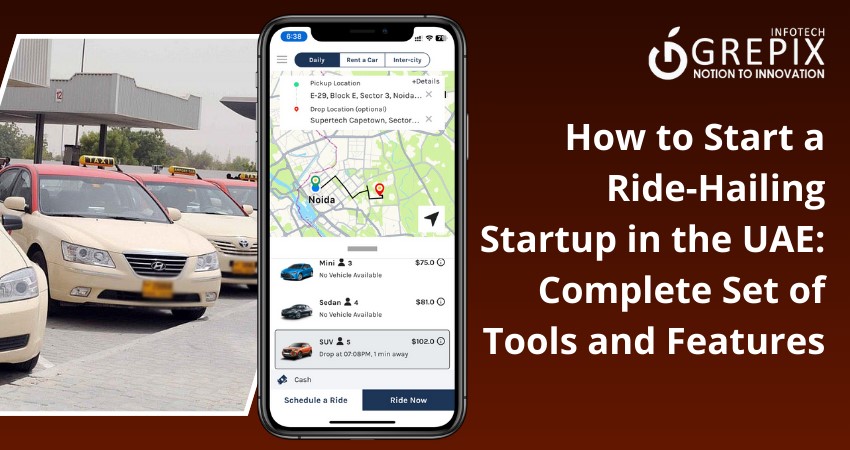How to Start a Ride-Hailing Startup in the UAE: Complete Set of Tools and Features
The UAE isn't just a luxury tourism hotspot it's a prime playground for tech-driven transport startups. With urban centers like Dubai and Abu Dhabi pushing toward smarter mobility, launching a ride-hailing service here is more than a good idea it's a lucrative opportunity.
In 2024, the online taxi market in the UAE hit a value of around USD 324 million, with projections suggesting it'll grow to USD 415 million by 2029. That's a 4.25% CAGR solid ground to build your business on.
Major players like Uber, Careem, and newcomers such as Bolt are already in the mix, but the market still has space for localized, niche, or tech-advanced platforms. Whether it's luxury rides, eco-friendly vehicles, or women-only services, differentiation is key.
Starting a taxi company in UAE means diving into a market that's demanding but full of potential. The key? Know your terrain, be compliant, and serve better than the rest.
Thinking about launching a ride-hailing startup in the UAE? This comprehensive guide walks you through every step from understanding UAE regulations and obtaining a taxi license to building the right app, recruiting drivers, and scaling your business across emirates. Whether you're eyeing Dubai's smart mobility scene or tapping into Sharjah's growing demand, this article offers practical strategies, cost estimates, and real-world insights to help you succeed. Learn how to differentiate your service model, market effectively, and manage operational risks while ensuring full regulatory compliance. With examples from industry giants like Uber, Careem, and Bolt, plus tips on pricing models, funding, and technology, this 2,500-word guide is your go-to resource for launching and growing a taxi company setup in the UAE. Includes a free launch checklist and expert tips for long-term success in the dynamic Middle Eastern ride-hailing landscape.
1UAE Taxi Market Overview
The UAE's taxi and ride-hailing sector is booming, driven by rapid urbanization, a tech-savvy population, and a strong push for smart mobility solutions. In 2024, the UAE's online taxi market was valued at approximately USD 324 million and is projected to reach USD 415 million by 2029, growing at a CAGR of 4.25%. Dubai Taxi Company (DTC), a major player, reported a 12% year-on-year revenue increase, totaling AED 1.92 billion in FY 2024, with its fleet expanding to nearly 6,000 vehicles.
The market is competitive, with global giants like Uber and Careem, as well as new entrants like Bolt, which launched in Dubai in partnership with DTC. This dynamic environment presents both opportunities and challenges for new ride-hailing startups aiming to carve out a niche.
2Understanding UAE Regulatory Environment
Navigating the regulatory landscape is crucial for establishing a ride-hailing business in the UAE. The Roads and Transport Authority (RTA) oversees transportation services in Dubai, and obtaining a taxi service permit involves several steps:
- Company Registration: Register your company with the Department of Economic Development (DED).
- Trade License: Secure a trade license specific to transportation services.
- Taxi Permit Application: Submit an application to the RTA, including a feasibility study, vehicle acquisition plan, and driver recruitment strategy.
- Vehicle Requirements: Plan to purchase between 250 and 500 vehicles, as specified during the RTA's auction process.
- Driver Qualifications: Ensure drivers have valid UAE driving licenses and undergo necessary training.
Compliance with these regulations is non-negotiable, and it's advisable to consult with local legal experts to navigate the process smoothly.
3Conducting In-Depth Market Research
Before launching, comprehensive market research is essential to understand the competitive landscape, customer preferences, and potential gaps in the market.
Key Areas to Explore:
- Competitor Analysis: Study existing players like Uber, Careem, and Bolt to understand their offerings, pricing models, and market share
- Customer Preferences: Conduct surveys and focus groups to gauge customer expectations regarding pricing, service quality, and app features.
- Regulatory Trends: Stay updated on any changes in transportation regulations that could impact your business model.
- Technology Adoption: Assess the penetration of smartphones and internet usage to determine the viability of app-based services.
Utilizing this data will help tailor your services to meet market demands effectively.
4Defining Your Service Model and Target Audience
Identifying your niche and target audience is critical for differentiation in a saturated market.
Potential Service Models:
- Standard Ride-Hailing: Compete directly with existing players by offering similar services with unique value propositions.
- Luxury Services: Cater to high-end clients seeking premium vehicles and personalized experiences.
- Eco-Friendly Options: Focus on sustainability by offering electric or hybrid vehicles.
- Specialized Services: Provide services tailored to specific demographics, such as women-only rides or services for people with disabilities.
Target Audience Considerations:
- Tourists: Offer multilingual support and integration with travel platforms.
- Corporate Clients: Provide business accounts with invoicing and priority services.
- Residents: Focus on daily commuters with subscription models or loyalty programs.
Clearly defining your service model and audience will guide your marketing strategies and operational decisions.
5Vehicle Acquisition and Driver Recruitment
Securing a reliable fleet and qualified drivers is foundational to your ride-hailing business.
1. Vehicle Acquisition:
- Purchase vs. Lease: Decide whether to buy vehicles outright or lease them, considering factors like capital availability and maintenance responsibilities.
- Vehicle Standards: Ensure vehicles meet RTA specifications, including safety features and emission standards.
- Fleet Size: Plan your fleet size based on projected demand and RTA requirements.
2. Driver Recruitment:
- Licensing: Hire drivers with valid UAE driving licenses and clean driving records.
- Training: Provide comprehensive training on customer service, navigation, and app usage.
- Background Checks: Conduct thorough background checks to ensure passenger safety.
A well-maintained fleet and professional drivers are key to building trust and ensuring customer satisfaction.
6Choosing the Right Dispatch Technology
Your dispatch system is the heartbeat of your ride-hailing startup. Without it, managing real-time bookings, tracking drivers, and ensuring timely pickups becomes nearly impossible. In the UAE, where customers expect fast, seamless, and tech-forward services, your technology stack will either make or break your startup.
1. Key Features to Include in Your Taxi App UAE
User App:
- Real-time GPS tracking
- Fare estimator
- Multiple payment options (card, cash, digital wallets)
- Ride history and digital receipts
- SOS/panic button
Driver App:
- Route optimization
- In-app navigation
- Trip scheduling and history
- Performance tracking
Admin Panel:
- Dashboard with KPIs
- Driver and vehicle management
- Real-time analytics
- Surge pricing configuration
2. Buy vs Build: What's Best for UAE?
Custom app development is ideal if you're planning to offer unique features or plan to scale massively. However, this route can take 6-9 months and cost AED 200,000–400,000. For startups with a tight budget or timeline, opting for a white-label taxi app might be smarter. These are pre-built platforms that can be customized with your branding and launched in weeks.
Don't forget about integration with RTA systems in Dubai or respective transport authorities in Abu Dhabi, Sharjah, etc., which may require compliance certifications or API linking.
Pro Tip: Look at successful apps like Careem or Bolt for inspiration, but don't copy—innovate on what they lack, such as better localization, lower driver commission rates, or faster customer support.
Also Read: Accelerating Your Fortune: Becoming a Billionaire in South Africa's Taxi Industry
7Crafting an Effective Marketing Strategy
It's not enough to start a taxi business in UAE, you need people to know it exists. That's where a solid marketing strategy comes in.
Phase 1: Pre-Launch Buzz
- Tease Your Brand: Launch on social media with teaser videos, countdowns, and influencer shout-outs.
- Referral Programs: Offer early bird users AED 50 in ride credits for each referral.
- Partnerships: Collaborate with hotels, airports, or tourism agencies to promote your brand.
Phase 2: Launch & Awareness
- Local SEO & Google My Business: Optimize for keywords like "cheap taxi service in UAE" or "Dubai airport taxi app."
- Ads That Work:
- Instagram & TikTok for millennials
- Facebook for families and older users
- LinkedIn ads for corporate clients
- Offline Channels: Bus stop ads, billboards near business districts, and airport screens.
Phase 3: Loyalty & Retention
- Ride Loyalty Programs: Every 10 rides = 1 free.
- Push Notifications: Share discount codes during holidays or events.
- Customer Feedback: Engage with every review and address complaints ASAP.
Hot Tip: User-generated content is your friend. Run contests that encourage riders to share their experiences on social using your hashtag.
8Financial Planning, Funding & Pricing Models
Let's talk money. Launching a taxi company setup in the UAE doesn't come cheap. Between regulatory fees, vehicles, tech development, and driver onboarding, your costs can spiral quickly.
1. Startup Cost Breakdown (Approximate)
Expense Category | Estimated Cost (AED):
- UAE Taxi License: 50,000–100,000
- Fleet Purchase (10 cars): 500,000–750,000
- App Development: 200,000–400,000
- Marketing Budget: 100,000+
- Staff Salaries (6 months): 300,000+
- Total: AED 1.2M–2M
2. Funding Options
- Angel Investors: Ideal for early-stage traction.
- VC Firms: If you can scale rapidly.
- Startup Incubators: Look into Dubai Future Accelerators.
- Bank Loans: Consider Emirates NBD's SME programs.
3. Smart Pricing Strategies
- Dynamic Pricing: Adjust prices based on time, demand, and weather.
- Flat Rates: For airport pickups or city transfers.
- Subscription Models: Unlimited rides within zones for a fixed monthly fee.
- Promo Codes: Encourage app downloads and repeat use.
Pro Tip: Use analytics to constantly fine-tune pricing. Understand when users drop off during booking, it's often due to unexpected fare hikes.
9Risk Management, Insurance & Compliance
Operating a taxi business in UAE without proper risk protocols is like driving blindfolded. Legal issues, accidents, or even a single viral customer complaint can tarnish your brand.
Key Compliance Areas
Insurance:
- Commercial vehicle insurance
- Third-party liability
- Driver medical coverage
RTA Mandates:
- Monthly inspections
- Driver training renewals
- Data reporting from your dispatch system
Data Security:
- Must comply with UAE's Personal Data Protection Law (PDPL)
- Use secure servers (preferably hosted in-country)
Legal Contracts:
- Driver contracts outlining duties, commissions, and conduct
- Waivers and terms of use for riders
Contingency Planning
- Accident Protocols: Train drivers on what to do in emergencies.
- Customer Complaints: Have a dedicated escalation channel.
- Cybersecurity: Use end-to-end encryption and regularly audit your platform.
Takeaway: Treat compliance as a culture, not a checklist. Regulators in the UAE are extremely strict—and for good reason.
10Step-by-Step Launch Checklist
Launching your taxi startup can feel like herding cats. Here's a bite-sized checklist to keep you on track.
Pre-Launch
- Market research
- Finalize service model & features
- Register company & apply for UAE taxi license
- Develop taxi app
- Acquire fleet
- Recruit and train drivers
Launch
- Soft launch in a small area (e.g., Dubai Marina)
- Gather initial feedback
- Launch full-scale marketing campaign
Post-Launch
- Monitor KPIs: average wait time, app downloads, retention rate
- Optimize tech and pricing based on real user data
- Prepare investor pitch for expansion
11Scaling Your Taxi Business for Growth
Once your taxi service in UAE gains traction, the next logical step is growth. But scaling isn't just about buying more cars or hiring more drivers—it's about building a solid, adaptable foundation that can handle expansion without falling apart.
1. Key Areas to Focus on During Scaling
- Start by targeting high-demand areas like Abu Dhabi, Sharjah, and Ajman.
- Research local transport authority regulations—each emirate may have slightly different rules compared to Dubai's RTA.
- Localize your app with language and cultural nuances (e.g., include Arabic and English language support).
- Automate driver onboarding with online verification.
- Use AI-powered dispatching to reduce idle times.
- Implement CRM tools to manage customer relations and feedback more efficiently.
- Consider switching to hybrid or electric vehicles to reduce costs and align with the UAE's sustainability goals.
- Use telematics to monitor fuel usage, driver behavior, and route efficiency.
- Add services like carpooling, delivery rides (especially for eCommerce), or even business class vehicles for corporate clients.
- Offer hourly rentals or out-of-city rides for special events or weekends.
- Collaborate with local businesses, hotels, and event organizers.
- Integrate your platform with mobility-as-a-service (MaaS) apps and travel aggregators.
- Understand and strictly follow UAE's regulatory framework.
- Build your brand around what current players are missing be it better pricing, faster support, or tailored user experiences.
- Invest in a powerful tech stack and never stop optimizing.
- Focus equally on customer satisfaction and driver loyalty happy drivers mean better service.
- Scaling is a marathon. Don't rush it; systematize before expanding.
Geographic Expansion:
Operational Automation:
Fleet Optimization:
Diversification of Services:
Strategic Partnerships:
Success Story Insight: Look at Careem's journey—from simple ride-hailing to now offering food delivery and payments. Diversification gave them market resilience.
Conclusion
Starting a ride-hailing startup in the UAE is more than launching an app it's about creating a reliable, compliant, and customer-focused transportation solution in a rapidly evolving market. The UAE offers tremendous opportunity, especially with cities like Dubai pushing for innovation under the Smart City initiative
Here's what to remember:
Your journey into the ride-hailing space will require resilience, smart planning, and continual learning but the rewards are substantial if done right.
FAQs
1. How much does it cost to start a ride-hailing business in the UAE?
On average, you'll need AED 1.2M–2M to cover licensing, vehicles, app development, and marketing. The figure can vary depending on fleet size and service model.
2. Do I need a special license to operate a taxi service in UAE?
Yes, a UAE taxi license is required, typically issued by the RTA in Dubai or relevant authorities in other emirates. It involves detailed applications, vehicle plans, and compliance documentation.
3. Is it better to build or buy a taxi app for the UAE market?
Buying a white-label solution is faster and more budget-friendly for startups. However, building a custom app offers greater flexibility if you're aiming for a unique value proposition.
4. What's the most effective way to attract drivers?
Offer competitive commissions, flexible hours, and bonuses. Provide easy onboarding, free driver training, and referral incentives to help scale your fleet quickly.
5. Can I operate in multiple emirates with one license?
Not directly. Each emirate may require separate permissions or operational guidelines. Always check with local transport authorities before expanding beyond your initial location.
Looking out to start your own venture like Uber? Try out our HireMe Taxi Uber Clone, the easiest way to kick-start your taxi business.







